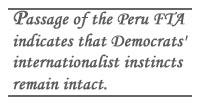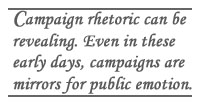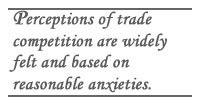How the Next US President Might Deal With Trade
How the Next US President Might Deal With Trade

WASHINGTON: Edgar Allan Poe’s pioneering detective story “The Purloined Letter” turns on an obvious but clever insight. Police ransack safes, corners and the insides of books for the missing letter. After thinking a moment, Inspector Dupin finds it hidden in plain sight on top of a desk – the only place where the police didn’t think to look.
Observers of American trade policy, wondering about where a Democratic administration might lead the US, can take inspiration from Dupin. Before analyzing speeches for coded messages, they should examine three clues available to all. One might be surprised to find that the issues shaping trade policy have little direct relation to commerce as such – health care and benefits for workers and growing automation of the US industry.
The first clue can be found in the actual decisions of the Democrats now running Congress. On taking over Congress a year ago, senior Democratic figures on trade policy – Ways and Means Committee Chairman Charles Rangel and Senate Finance Committee chief Max Baucus – both said that they hoped to make trade policy work. A year later they do so, with support from House leaders Nancy Pelosi and Dennis Hoyer. The House has taken two steps in that direction by approving a new, more ambitious program of help for workers laid off because of imports and industry shifting overseas as well as moving on to pass a trade agreement with Peru, modified to accommodate party goals on “core labor standards” and environmental policies, and scaling back patent requirements for medicines.
This agreement is relatively modest. Covering about $10 billion in annual US-Peru trade – barely ten days’ worth of the US $600 billion in annual trade with Canada – its effects will be more important in South America than for the US.

The revisions didn’t end the Democrats’ 40-year split over trade. Party members have doggedly argued over the topic since the trade union movement turned against President Lyndon Johnson’s trade negotiating agenda in the 1960s. The Peru agreement accordingly fell slightly short of a majority of the party in the House and aroused some spirited opposition. But it nonetheless received more House Democratic votes than almost any trade agreement of the last two decades. Its passage indicates that the party’s internationalist instincts remain intact and that the main questions, at least for next year, are more about the shape and speed of trade policy than the direction.
The second clue is real-world trends in American trade. Here, rapidly improving export performance is an exception to the nation’s generally gloomy economic outlook. US exports rose by $160 billion in 2006 and will probably match that pace this year. Manufacturing exports have nearly doubled since 2004, services exports are likely to pass the half-trillion mark this year, farm goods approach the $100 billion mark, and the national trade imbalance is beginning to drop. With financial troubles in housing and construction, and possibly weaker consumer spending, exports are the principal economic good news of the past two years for the US. American industries such as semiconductor manufacturing, some forms of medical equipment and even some entertainment businesses earn more from foreign than domestic sales. A new administration of either party must take this into account in forming trade and other economic policies.

The third clue rests in the presidential campaign – in both parties. As January’s Iowa caucuses and New Hampshire primary approach, the tone on trade is noticeably darker. Even the agreement with Peru has sparked some fears among Democratic candidates. Frontrunners Hillary Clinton and Barack Obama have been cautious, coupling their endorsements of trade with unhappy comments about the North American Free Trade Agreement and suggestions of a slow pace for future trade policy. Lagging candidates are harsher. Senator Chris Dodd, once a champion of economic development in Latin America, warns that the Peru agreement will “take jobs away from hardworking Americans and ship them elsewhere.” John Edwards attacks congressional Democrats backing the agreement for favoring “big multinational corporations.”
Republican candidates so far have made trade a minor issue – their substitute is immigration. Even for candidates whose states are full of immigrant scientists and entrepreneurs – like Mitt Romney from Massachusetts and Rudy Giuliani from New York – the topic evokes resentment over eroding job security.
To some extent, early-primary rhetoric in either party can be discounted. The 350,000 Iowa caucus and New Hampshire primary participants are likely to weed out half the early candidates by mid-January, and thus a few thousand votes can mean the difference between a second-tier candidate’s extinction and survival. So, leading candidates avoid positions that might antagonize a bloc of voters. Their struggling rivals, meanwhile, adopt hot rhetoric and exaggerated positions designed for maximum appeal among organized constituency groups.
Still, the campaign rhetoric is revealing. Campaigns are not solely arenas for tactical maneuvering, but also, even in these early days, mirrors for public emotion. In this sense, the parallel angst over trade and immigration are evidence of anxiety over a changing economy – and that anxiety has some strong foundations.

America’s economy is flowing and changing rapidly. Global competition, information technology and the internet, mass immigration, economic integration in Asia and other forces all contribute. The changes are not all for the worse, of course. America’s often-troubled manufacturing industry has grown from $1.3 trillion to $1.6 trillion since 2001, developing new specialties in medical technology, environmental products, nanotechnology and other 21st-century industries. Economists celebrate rising US productivity, but it often translates into machines producing more goods while factories shed workers. Adapting to competition from low-cost labor in Asia, companies have substituted computers and robots for 3 million human workers this decade. As satellites, fiber-optic cables and broadband technology combine to create a global services industry, even larger upheavals could rumble in the future.
Such change, stressful enough on its own, is even more so in the context of other changes in American working life. Businesses have reduced their role as providers of health care and pensions. US workers choose more mobile, less secure careers, with advancement based on lateral moves among companies rather than the “corporate ladders” and shop-floor promotions familiar to earlier generations. Both trends undo earlier guarantees of security in sickness and old age, raising risks for middle-class workers. Neither government nor unions have stepped forward to fill the gaps.

Even with five years of growth and relatively low unemployment, therefore, Americans are not wrong to worry and expect something more. The challenge for Democrats is to remain grounded in the instincts of their congressional leaders, with their internationalism and willingness to adapt to the globalizing world, while never forgetting core supporters among blue-collar workers and the poor – and that means grappling with anxieties the primary campaigns reveal among the broad public.
Pelosi’s comment after the passage of the Peru agreement is to the point: “How many people in America think they have lost their jobs over trade and immigration?” Her answer is “many more than those who have.” Perceptions of powerful immigrant and trade competition are widely felt and, even if the actual causes are diffuse and the problems less rooted in international factors than many believe, based on reasonable anxieties. Major achievements in either area, she suggests, will be difficult without progress on health care, pensions and other guarantees of security in a changing global economy.
Those who ponder future Democratic trade policy might find her comment a good place to start. Like all the best clues to American policy, it’s hidden in plain sight.
Edward Gresser is director of the Progressive Policy Institute’s Project on Trade and Global Markets.